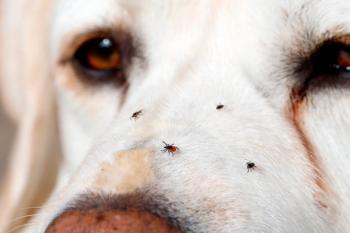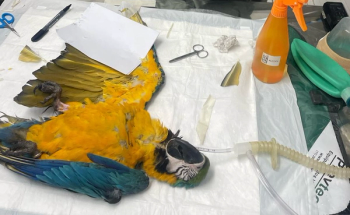
An Update on Canine Lymphoma
In a review article published in Frontiers in Veterinary Science, Luca Aresu, DVM, PhD, from the University of Padova, Legnaro, Italy, reviews some of the most recent advances and the characteristics of canine DLBCL.
Lymphoma is the most common hematopoietic neoplasm and the most common aggressive B-cell lymphoma in dogs. It comprises a collection of cancers that arise from the malignant transformation of B and T lymphocytes.
Diffuse large B-cell lymphoma (DLBCL) is the most frequent lymphoma type in dogs. However, despite increased understanding of this disease, its classification, treatment, and prognosis remain challenging for veterinarians.
In a review article published in
Diagnosis
Pathologists use a combination of histopathology and immunohistochemistry (IHC) to make a morphologic diagnosis of lymphoma—ideally, on the basis of evaluation of a whole lymph node. Diagnosis is typically based on the World Health Organization histopathologic classification system, according to features of neoplastic growth pattern, nuclear size, nuclear morphology, number of mitoses per high-power field, and immunophenotype.
DLBCL is characterized by a diffuse proliferation of large neoplastic lymphoid cells, the nuclei of which are more than twice the size of red blood cells. The centroblast variant is most common, and is characterized by a diffuse proliferation of large, non-cleaved cells resembling the proliferating cells of the germinal center (GC); they have round to oval vesicular nuclei with fine chromatin, little amphophilic to basophilic cytoplasm, and multiple prominent nucleoli. The immunoblast variant in dogs is less common, and is clinically more aggressive. Immunohistochemically, DLBCLs express CD79, CD20, and the nuclear transcription factor PAX5.
Clinical Features
“Dogs with DLBCL have variable clinical course, response to treatment, and prognosis, which may depend on many clinicopathological and morphological parameters,” writes Dr Aresu.
Affected dogs have moderately to severely enlarged peripheral lymph nodes, and a cut-off of 3% bone marrow (BM) infiltration by neoplastic cells has the strongest value to differentiate between animals with a poorer versus better prognosis.
The number of mitoses present in the neoplasm on histopathological evaluation is also associated with prognosis. In one study, median survival time was 188 days in dogs if the tumor contained fewer than 20 mitoses per 400x field, compared with 31 days if it contained more than 20 mitoses per 400x field.
Molecular Pathogenesis
Transcriptome analysis has identified altered expression of 3,286 genes in dogs with DLBCL, most of which were downregulated compared with normal lymphocytes.
Human DLBCL is differentiated into two distinct subtypes with different survival rates after chemotherapy: one is characterized by expression of genes typical of germinal center (GC) B cells, and the other by expression of genes that are upregulated in activated B cells (ABC). GC DLBCL typically responds more favorably to rituximab treatment and chemotherapy.
Similarly, genes that differentiate these two subtypes in humans also separate canine B-cell lymphomas into two groups with significantly different survival times. The most significant of these genes are also involved in the same pathways and processes that are involved in human DLBCL, in particular, NF-κB signaling and B-cell receptor signalling.
Genetics
Most cancers, including lymphoma, have an abnormal chromosomal content with clonal changes in chromosomal structure and number. “[G]enes that display abnormal expression in aberrant chromosomal regions are likely to be key players in tumor initiation and progression,” writes Dr Aresu.
In one study of canine DLBCL, a gain of chromosome 13 occurred significantly more commonly in dogs that experienced a complete response after treatment, than in dogs that either relapsed during treatment or were initially diagnosed with stage 3 or stage 4 disease. In contrast, a gain of chromosome 31 was associated with a worse prognosis.
In dogs with relapsed DLBCL, one study showed these tumors to contain fewer genomic imbalances that are equally distributed in gains and losses. At least one common genomic abnormality was found in both the primary tumor and the relapse sample, confirming the clonal relationship between the lesions.
Changes in DNA Methylation
According to Dr Aresu, “DNA methylation has been demonstrated to play a key role in hematopoietic tumor development, to contribute to disease phenotype, and to be therapy related predicting patient survival”. DNA methylation is a key epigenetic factor in the regulation of gene expression and genomic stability, and has also improved the classification of human DLBCLs.
Although this process has been poorly studied in dogs, one study showed a high frequency of hypermethylation of the tumor suppressor DAPK in canine nodal high-grade B-cell lymphomas. Another demonstrated p16 hypermethylation and consequent silencing in some lymphoma cell lines. A recent study also showed that epigenetic dysregulation (CpG island hypermethylation) of tissue factor pathway inhibitor 2 (TFPI-2), leading to its reduced expression, is commonly detected in canine DLBCL.
According to Dr Aresu, canine DLBCL therefore can no longer considered a single disease, because its biological behavior depends on its origin, association with mitotic index, blood and BM tumor infiltration, and specific genomic aberrations.
“In the future, therapeutic decisions will increasingly be correlated to the analysis of these data, and their significance need to be further validated in a larger cohort of dogs,” he concludes.
Dr. Parry graduated from the University of Liverpool, England in 1997 and is a board-certified veterinary pathologist. After 13 years working in academia, she founded Midwest Veterinary Pathology, LLC where she now works as a private consultant. She is passionate about veterinary education and serves on the Indiana Veterinary Medical Association’s Continuing Education Committee. She regularly writes continuing education articles for veterinary organizations and journals, and has also served on the American College of Veterinary Pathologists’ Examination Committee and Education Committee.
Feature Picture Source: Libertas Academica / flickr /
Newsletter
From exam room tips to practice management insights, get trusted veterinary news delivered straight to your inbox—subscribe to dvm360.






